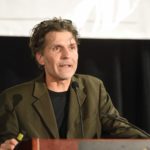
August 2019
I. LEAVING THE CHURCH
On a family trip to upstate New York when I was a kid, we visited the Sacred Grove. As we were leaving I saw, on the edge of the grove, two personages. Handing out literature.
You were probably picturing these two personages like this [whoops, a picture is missing!], like the pictures of the First Vision that you have seen. But this would be more close to the reality of it.

And it would even be more accurate to picture them like this, because these people were, in fact, Raelians – they were members of a UFO religion – and their tract that they were handing out argued that the First Vision was Joseph Smith being visited by extraterrestrials.
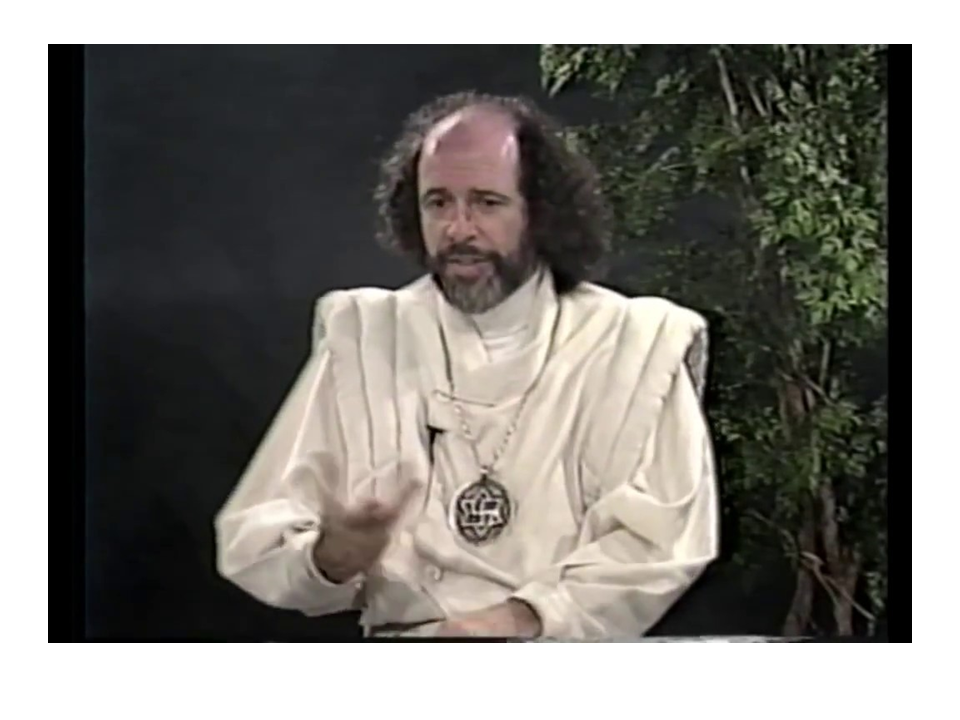
This is actually a true story. My mom remembered that incident better than I did, because I was only about eleven years old. I am not really sure if it was one personage or two in the experience, so my accounts of it may vary over time.
Much has been written on the First Vision – so much, in fact, that one might wonder how much more could there be to be said on the subject. I can promise you that there is quite a bit. I think, in fact, that after nearly two centuries we are just beginning to understand what happened that spring morning—and what its implications are for our understanding of the Gospel, and for our lives.
Around the year 2000, I started wrestling deeply with my religious belief. I had a faith crisis, even before it was cool. On Pioneer Day 2005 I hand delivered a letter resigning my membership from the Church to my bishop. I did not, at the time, believe any more and I didn’t think I had anything to offer to the Church.
Among the things I did not believe in was the First Vision. I thought the First Vision existed only as a narrative, not as an actual event. In short, I believed that Joseph Smith had made it up.
After I met with the bishop, I also met with my stake president. One of the last things that the stake president said to me as I was leaving was that he had a feeling that I would be back, that I would return to the Church.
I knew I wasn’t coming back to church! But I didn’t want this nice man to feel any worse than he had to in this situation, so I did this quick mental analysis of the situation. I remembered that Blake Ostler had taught me in my intro to philosophy class at the BYU Salt Lake Center that if something wasn’t inherently contradictory—like a married bachelor– it was logically “possible,” so I said with that thought in mind, “It’s possible.” I thought it was absolutely never actually going to happen.
While I was outside the Church, I continued avidly digging into Church history; I just was fascinated with what happened, including understanding the First Vision. Although I then believed that the First Vision existed only as a narrative, I thought it was a narrative that was worth exploring. I wanted to understand what the original First Vision (meaning, for me, the original narrative that Joseph Smith had told) was, and what its significance was – that is, what function the narrative filled. In spring 2010, nearly five years after leaving the Church, I began writing a new paper. In that paper I theorized that the First Vision was the origin story behind Joseph Smith’s role as a seer – that it was the event from which he was supposed to have derived his gift of seeing.
In the early days of May of that year, I was sitting in the library café at Utah State University, and I wrote and worked more on my ideas for this paper. Dots started to connect in ways that I couldn’t have guessed. I feverishly recorded a bunch of new ideas, realizing that the First Vision was an endowment. That it was a revelation of staggering expansiveness, and that it was an actualization of some of the most powerful doctrines of the Restoration. Going into that writing session in the library, I had had absolutely no intention of returning to the Church, didn’t believe that was even possible for me, and I was actually happily serving as one of the leaders of the local Baha’i community. I had become a Baha’i at that time. While it would take much more soul searching, reflection on my own spiritual experiences, and personal work before I was fully ready to return to the Church, by the time that writing session in the library ended, I was penetrated by one of the most startling realizations of my life: “I am going back to the Church.”
Up until the very moment that this happened, the idea that this research would lead me back to the Church—and to be standing here presenting that very research at the FairMormon Conference—is something I could have only understood at the time as a joke! I can easily imagine saying something to fellow ex-Mormon friends, and I have a particular friend in mind who is no longer an ex-Mormon, before this turning point about someday presenting my research at the FairMormon Conference—but at that point I can only imagine saying this as a joke—and a riotously funny one at that.
What in the heck happened?!
How did I end up here?
In proof that God has a rich sense of humor, here I am, and I will tell you how I ended up here.
II. THESIS STATEMENT: THE FIRST VISION WAS AN ENDOWMENT AND AN ENACTMENT OF THE GOSPEL
The thesis of what I have to say today is that the First Vision was an endowment and an enactment of the Gospel of Jesus Christ.
What I started to see that day at the USU library, but that took a while for it to fully dawn on me in all its implications, is that, yes, the First Vision was Joseph Smith’s calling as a seer, as I had been hypothesizing, but it was also more than that. It was also his initiation as a seer, and that this initiation was a kind of endowment, anticipating the temple ritual the Prophet started to reveal to others in Nauvoo. I started to see that Joseph Smith’s First Vision “endowment” also prefigured what we tend to think of as “Nauvoo” doctrine, particularly the doctrine of exaltation. And, most importantly, my eyes began to be opened to see that the foundational event of the Restoration, Joseph Smith’s First Vision, was an encapsulation—and potent demonstration—of the Gospel of Jesus Christ.
We may be inclined to think of Joseph Smith’s First Vision as only a revelation about the restoration of the Church. He was told that the true church was not on the earth; but that it was coming. This is not inaccurate. This is mostly how we talk about the First Vision What I want to submit to you today is that the First Vision was so much more.
More than a revelation about the restoration of the church and the Gospel, the First Vision was also a revelation of the Gospel—an encapsulation of the entire plan of redemption, and a manifestation of the redeeming power of Christ. It is, in fact, the spiritual experience that most completely sums up the Gospel and the most powerful manifestation of the redeeming power of Christ that I, as a historian of religion, have ever encountered.
III. THE FIRST VISION WAS AN ENDOWMENT
The First Vision was an endowment. What do I mean by this? I will be going through each of these things.
The First Vision was esoteric, and I will talk about what I mean by that. The First Vision was an initiation and involved the blessing [or] touching of Joseph’s eyes. The First Vision involved a “lifting up” and what that term means; also, “exaltation.” The First Vision led to the recovery of Joseph’s “white stone,” his first seer stone, an object that is linked in scripture with receiving a new name. And the First Vision began Joseph Smith’s process of acquiring divine attributes, that is of becoming like God.
A. THE FIRST VISION WAS ESOTERIC
Let’s start with the First Vision being esoteric. What do I mean by that?
By esoteric I mean that it involves higher levels of truth that are withheld until people are prepared for them.
Joseph Smith doesn’t just walk out of the Grove and tell people “Here is everything that I experienced; here is everything I learned.” How do we know that?
A couple of things; one thing that hints in that direction, and there is something more direct than that.
1. The First Vision Parallels Christ’s Transfiguration
The First Vision parallels Christ’s Transfiguration on the Mount of Transfiguration. The familiar words of the First Vision, “This is My Beloved Son. Hear Him” are actually those spoken by God the Father to Peter, James, and John, at the Mount of Transfiguration in Matthew 17. There is a kind of Biblical echo in what the Father says in the beginning of the First Vision.
That transfiguration experience was itself esoteric. Peter, James, and John were told by Jesus to keep it secret. When “they came down from the mountain, Jesus charged them, saying, Tell the vision to no man, until the Son of man be risen again from the dead” (Matthew 17:9).
2. Joseph Smith Kept the First Vision Esoteric
Joseph Smith actually kept his own First Vision esoteric, and he actually tells us this, although we kind of have to have eyes to see what he is telling us. He kept it esoteric from the start.
So Joseph tells that after the vision when he was physically weak after the experience he went home. “…as I leaned up to the fireplace, mother inquired what the matter was. I replied, ‘Never mind, all is well–I am well enough off.’ I then said to my mother, ‘I have learned for myself that Presbyterianism is not true’” (JS-H 1:20).
FULL STOP!
You just saw God! And all you say to Mom is, “You know that church you are going to? Uh-uh. That’s not right.”
That was what was relevant to her at that time.
So from the very moment he comes out of the Grove, the first time he talks to someone else about the First Vision, he holds back 99.99% of what that experience was, and just gives out the part that is immediately relevant.
So it is easy for us to look at that and think, “Ah! That’s all she found out at that time, but we know. We know the whole story!”
What I am going to submit is: No, we don’t; Joseph Smith was always doing the same thing that he did with his mother with all the audiences he talked to. To varying degrees, he was withholding things based on how prepared his audience was and what their needs were.
If Joseph only told elements of the First Vision to others as they were ready for them, then it is significant to note that the familiar published accounts of the First Vision were all either written for general publication or recorded as Joseph narrated them to a non-Latter-day Saint audience. In other words, the familiar accounts of the First Vision that we have were given precisely in contexts directed to audiences where we would expect Joseph to have held back much of the experience.
In contexts of faith, where Joseph was relating his experience to the Saints, rather than to the non-Latter-day Saint public, we would expect him to have disclosed additional details.
Fortunately, there are times when Joseph told the vision to a Latter-day Saint audience rather than to outsiders.

a. 1844 Alexander Neibaur journal account:
One of these, not actually the first chronologically, was in 1844, recorded in Alexander Neibaur’s journal.
In that account Joseph does give details that are not in his published accounts. He talks more about Christ’s appearance. He talks a little bit specifically about Christ’s robe in a way that would be interesting for Latter-day Saints who have been through the temple, but would not be relevant or appropriate to talk about to the public
b. John Alger account from the journal of Charles Lowell Walker
Another account that we will be discussing further is one given in Kirtland at the home of Joseph Smith, Sr., and reported by John Alger.
c. June 11, 1843 sermon
Another is a sermon Joseph gave in Nauvoo, June 11, 1843.
B. THE FIRST VISION WAS PART OF JOSEPH SMITH’S INITIATION AS A SEER

The First Vision was also Joseph’s initiation into seership. This was the idea I started working on for this paper. We call it Joseph’s First Vision. He referred to it at one time by the words, “the first vision of angels,” or something like that.
So if this is his first vision, if a vision is an experience of seeing things that are not visible to the natural eye, seeing with spiritual eyes, then the First Vision is Joseph’s first experience of second sight. It is the first time that he is acting as a seer.
It is also reported, and I will talk about this presently, by John Alger, that the First Vision actually involved the touching of Joseph’s eyes so that he could see spiritual things, as part of the initiation.
This vision led to the finding of his first seer stone, which we will also discuss further.
C. THE FIRST VISION INVOLVED THE TOUCHING OF JOSEPH SMITH’S EYES TO GIVE HIM SIGHT
JOHN ALGER ACCOUNT
1893, was recorded by Charles Lowell Walker in his journal: 2nd Feb Thurs … Attended Fast Meeting … Br John Alger said while speaking of the Prophet Joseph, that when he, John, was a small boy he heard the Prophet Joseph relate his vision of seeing The Father and the Son, That God touched his eyes with his finger and said “Joseph this is my beloved Son hear him.” As soon as the Lord had touched his eyes with his finger he immediately saw the Savior. After meeting, a few of us questioned him about the matter and he told us at the bottom of the meeting house steps that he was in the House of Father Smith in Kirtland when Joseph made this declaration, and that Joseph while speaking of it put his finger to his right eye, suiting the action with the words so as to illustrate and at the same time impress the occurence [sic] on the minds of those unto whom He was speaking.
I will just summarize here a little bit.
This account is from much later, it is from the early 1890s. I will talk in a minute about why I would argue that it’s trustworthy.
This is from John Alger, the brother of the famous Fanny Alger, or as we generally mis-pronounce her name, Fanny Algert, who lived with the Smiths for some time. When John Alger was in Kirtland at the Joseph Smith, Sr., home one time, he heard Joseph, Jr., relate the First Vision, and Joseph said that the Father touched his eyes and this was part of what enabled him to spiritually see. Well, he says God touched his eyes. And then he said that Joseph pointed to his eyes as he made this statement.

So why would we trust John Alger‘s account? It is a very late account.
First, the close connection with the Smiths particularly through Fanny Alger. Second, John Alger recalled physical details relating to this telling; the pointing to the eyes. John Alger’s account relating unique details of the First Vision is something we would expect when we realize that this account is actually the only account that we have of someone telling the First Vision in the intimacy of a Smith family setting. This is at the Joseph Smith, Sr., home. The detail from John Alger’s account matches a pattern for the giving of physical and spiritual sight in the scriptures that involves the touching of the eyes.
So let us look at that pattern.

In the Bible we have the first thing I point to is not exact, but it is analogous. Isaiah’s mouth was touched, and then he was able to speak prophetically with his mouth. This would be parallel to Joseph’s eyes being touched in the course of his function as a seer.
In the Book of Abraham, Abraham 3, Abraham says he placed his hand on his eyes, and then he could see the stars and the worlds that God had created.
Jesus, in the Gospels, touches the eyes of the blind and heals them.
Enoch, in the Book of Moses, by God’s command, when acting part of God’s prophecy, anoints his own eyes with clay, which is one of the ways that Jesus healed the blind, anointing their eyes with clay.
This one potentially takes a little bit more explanation but I am just going to sum it up. In the story of the brother of Jared, of course, the Lord does not touch his eyes, but the brother of Jared wants to be able to see. That is the issue, just like with the blind. The Lord asks him, “What will ye that I should do for you?” What he wants is for the Lord to touch these stones so that they can see. And then the Lord also gives him with those two other stones that He has touched, the interpreters, that enable the brother of Jared to act as a seer. And others, later, to act as seers with these interpreters.
So that question, it has been pointed out before, that the Lord asked the brother of Jared, “What is it that ye would that I should do for you?” happens to be the very question that Jesus asks the blind in the synoptic Gospels, and then they say, “Lord that we might see” and he touches their eyes so that they can see. So there is a scriptural theme of the sanctifying by touching, particularly or the opening of the eyes of the physically or spiritually blind by the touching of the eyes.
D. THE FIRST VISION DID NOT ALL OCCUR IN THE GROVE: IT INVOLVED A HEAVENLY ASCENT, A “LIFTING UP” OR “EXALTATION”
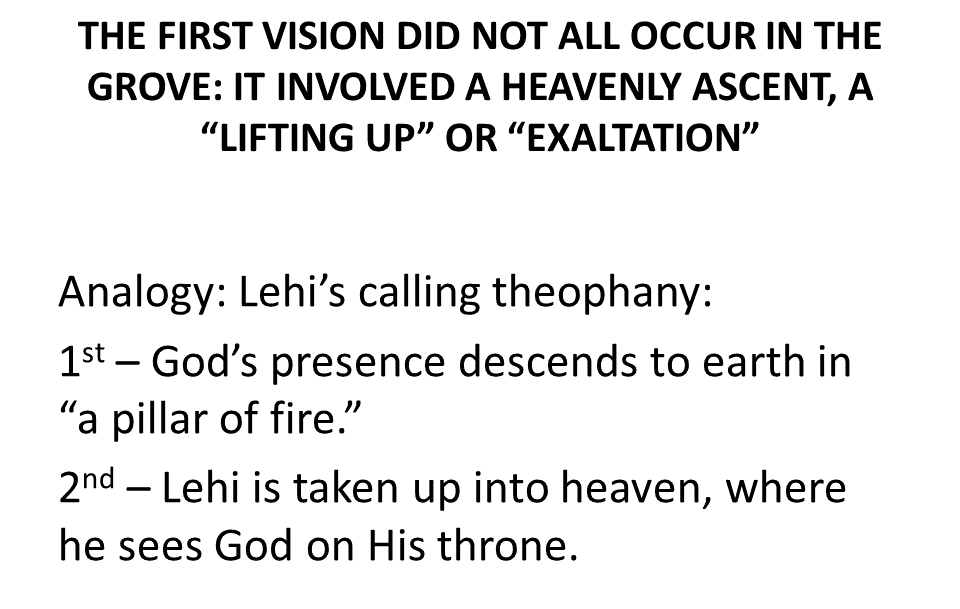
The First Vision, I’ll also argue, did not all occur in the Grove. It involved a heavenly ascent, which I will return to this idea later. It was a kind of “lifting up” or “exaltation,” which means lifting up.
As an analogy, let’s look at Lehi’s calling theophany, right at the very beginning of The Book of Mormon.
The first part of this experience is that God’s presence descends to earth, a pillar of fire comes and rests before Lehi. Then, part two of the calling theophany, Lehi is taken up into heaven, where he sees God on His throne.
So, the Divine Presence comes down to the person. Then God lifts the person up to where God is in heaven. This, I am arguing, is what happens with Joseph Smith. Lehi’s First Vision, is also, I am arguing, what happened in Joseph Smith’s First Vision.
Joseph’s First Vision Begins on Earth…
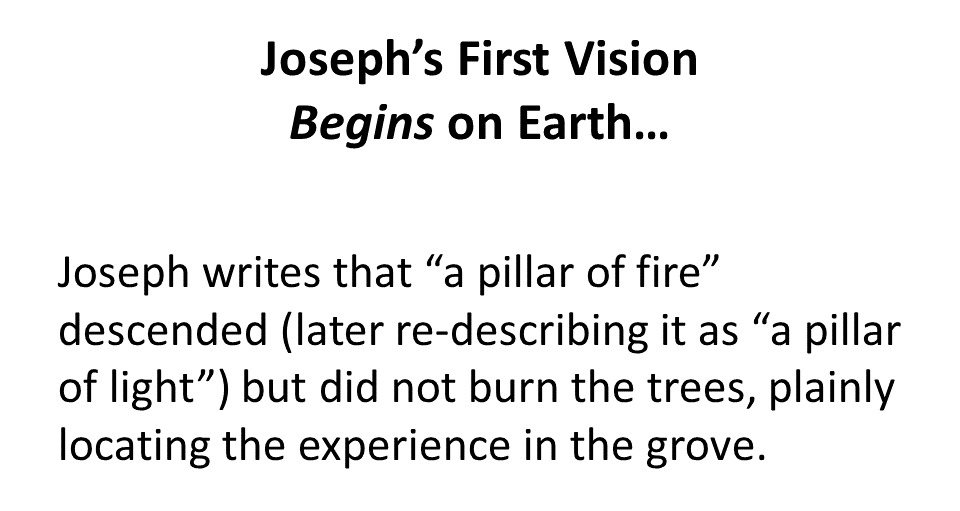
So Joseph’s First Vision begins on Earth. In his 1832 account he writes that “a pillar of fire descended.” He changes that, crosses out fire, and later makes it “light.” It is more familiar to us. He says that the pillar of fire did not burn the trees, so he is still seeing the Grove at the beginning of the experience. God comes into the Grove, the experience is located on earth. Then, I would argue, it moves to heaven.
… And Moves to Heaven
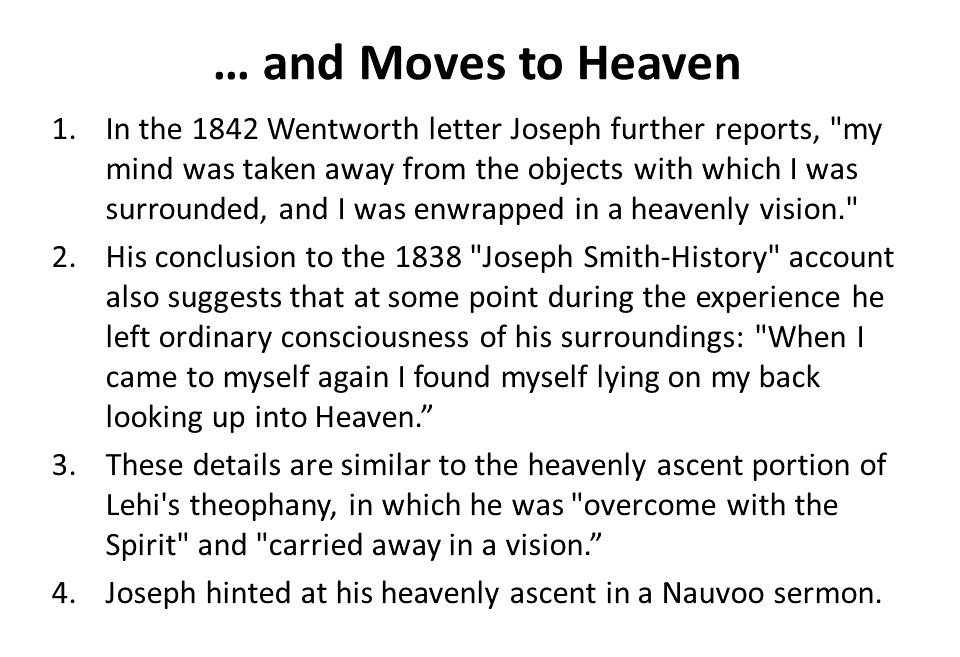
We have a few indications pointing this way.
In the 1842 Wentworth letter Joseph reports, “My mind was taken away from the objects with which I was surrounded, and I was enwrapped in a heavenly vision.” It doesn’t sound like he was just there sitting in the Grove. In the conclusion to his official “Joseph Smith-History” account, he also suggests that at some point during the experience he left the ordinary consciousness of his surroundings. He says, “When I came to myself again, I found myself lying on my back looking up into Heaven.” His mind is taken away from his natural surroundings and then he has to come to himself again, and find himself lying there in the Grove. Those details are similar to the heavenly ascent portion of Lehi’s theophany, which we just discussed, in which he was “overcome by the Spirit” and “carried away in a vision.”
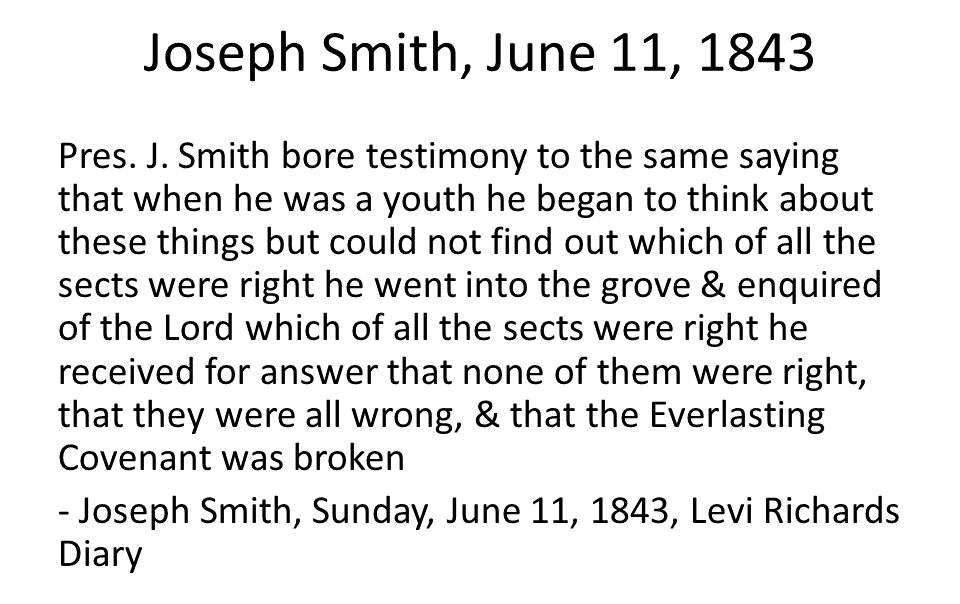
Joseph hinted at this heavenly assent aspect of his First Vision in a Nauvoo sermon. On June 11, 1843, Joseph talked about how he prayed about which of all the sects were right, he went into the Grove, and inquired of the Lord.
In the same sermon, Joseph is talking about the members of the Godhead. He says,
If they were to be stuffed into one person that would make a great God. If I were to testify (he is mocking the idea that the persons of the Godhead could all be one person) that the world was wrong on this point it would be true. Peter says that Jesus Christ sat on the right hand of God. [So note here the parallel with Joseph Smith’s own experience where he sees the Father, and on his right hand, the Son.] Any person that has seen the heavens opened knows that their [sic] is three personages in the heavens holding the Keys of Power.
– Joseph Smith, Sunday, June 11, 1843, Wilford Woodruff Diary
What I find interesting here is that in this sermon Joseph is talking about his own First Vision experience and some of its implications for understanding that the persons of the Godhead are not just one person. They are separate as he had seen the Father and the Son being.
And then he throws in, “anybody who has seen the heavens open knows this.” Well, why does he drop in something about seeing into the heavens when he is talking about the First Vision? I am going to suggest that, in line with these other evidences, what Joseph is hinting at here is that he, as part of the First Vision, had a heavenly ascent like Lehi.
E. THE FIRST VISION LED TO JOSEPH SMITH LOCATING HIS WHITE STONE
The First Vision led to Joseph Smith locating his white seer stone. This is part of this endowment theme.
So we have an account, it is from the 1826 hearing for “glass-looking.” He is charged with “glass-looking.” He told how he came to find his first seer stone.
Joseph Smith Testimony on Locating His White Seer Stone
He goes and looks in someone else’s (he knew someone else who had a seer stone); he looks in her stone. And “[h]e was greatly surprised to see but one thing, which was a small stone, a great way off. It soon became luminous and dazzled his eyes, and after a short time it became as intense as the midday sun.”
Does that sound familiar? He sees a light, and then it grows brighter and brighter until it’s as bright as the noon day sun. In the wake of Joseph’s First Vision, this is a similar experience which surely has echoed. If I can catch the connection there, he would have.
So, after having had his eyes touched, having seen his First Vision, having become a seer, he is then being led to his first seer stone, his white stone.
The Significance of a White Stone
What is the significance of a white stone? In the book of Revelation, it says, ”To him that overcometh… I will give him a white stone, and in the stone a new name written, which no man knoweth saving he that receiveth it.” (wink, wink)
The significance of a white stone Joseph also talked about in 1843, from D&C 130, it says that “…the white stone mentioned in Revelation 2:17, …is given to …those who come into the celestial kingdom, whereon a new name [is] written, which no man knoweth save he that receiveth it. The new name is the key word.”
Joseph received his white stone in the wake of the First Vision. This process of being initiated as a seer, where his eyes are touched so that he can see, and then he is given a stone that is connected with a new name, and so on, and revelation of truth that he can’t just go out and share willy-nilly. There is an endowment scene here.
F. IN ACQUIRING THE GIFT OF SEEING AND A SEER STONE, JOSEPH SMITH ACQUIRED A DIVINE ATTRIBUTE: WISDOM
To Become a Seer was to Acquire a Divine Attribute
Through the First Vision, Joseph acquired a divine attribute. Joseph Smith goes into the First Vision seeking wisdom, he says, partly seeking information. He wants to know which church is true. But wisdom is more than just information. Wisdom is also a divine attribute. To have wisdom, in this sense, would be to see as God sees, and understand as God understands.
So to become a seer was to acquire a divine attribute. In having his eyes touched by an all-wise, all-seeing God, Joseph Smith received divine sight, divine wisdom.
To use, maybe, a word that gets across the idea, even though it is not the best word, being all-seeing is kind of contagious here. God touches you, an all-seeing God touches your eyes, you see everything.
Joseph reports as much in describing finding his white stone. This is again from the account of his 1826 hearing.
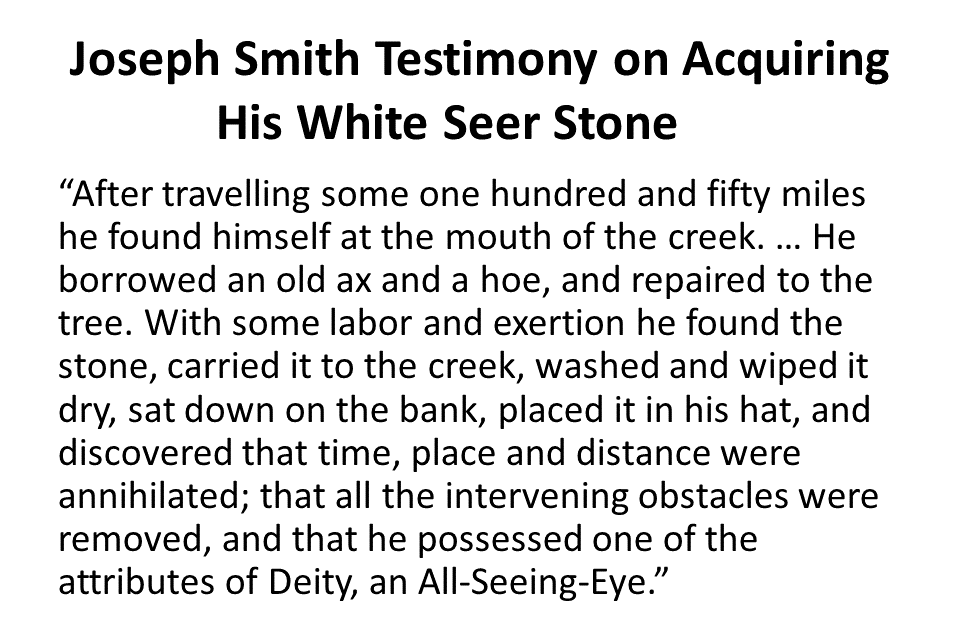
Joseph says that when he travels, (it is a big story, which I won’t go into), but he travels over by Lake Erie [I tried to find the place where this happened, by the way]. Joseph digs up this white stone from under a tree, placed it is his hat, and discovered that time, place and distance were annihilated; that all intervening obstacles were removed, and that he possessed one of the attributes of Deity, an All-Seeing Eye.”
So, of course, an All-Seeing Eye, we have got that as temple symbolism, and, of course, this is one of the attributes of Deity.
Joseph Smith’s First Vision Anticipates Exaltation Itself
The two scriptural terms for being taken up to God, the Book of Mormon talks a lot about being lifted up at the last day. The word “exalted” is so familiar to us in a certain context, meaning “becoming like God” and deification, that we don’t necessarily think about what does the word literally mean? Why was this term chosen? It means to be lifted up. Jesus says everyone who exalts himself will be abased, and whoever abases himself will be exalted.
In the First Vision, God descended to Joseph in the Grove to lift him up, that is, to exalt him, and to begin granting him divine attributes, beginning with Wisdom.
IV. THE FIRST VISION WAS AN EPITOME—AND CONCRETE MANIFESTATION—OF THE GOSPEL OF JESUS CHRIST
The First Vision was an endowment, it was also an epitome–and a concrete manifestation–of the Gospel of Jesus Christ.
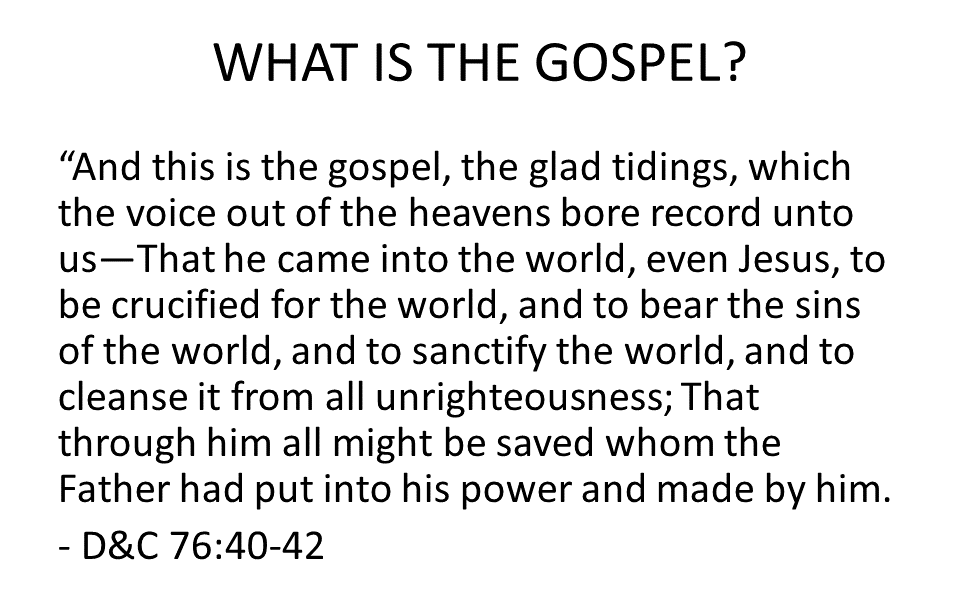
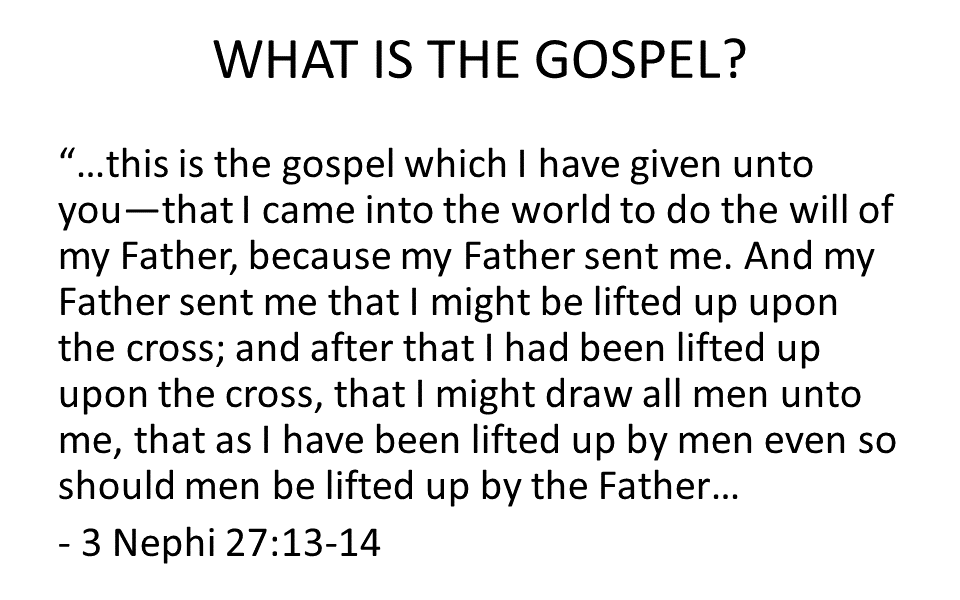
What is the Gospel?
- In section 76, it says that “…he came into the world, even Jesus, to be crucified for the world, and to bear the sins of the world” to save us.
- In 3 Nephi Jesus says that he came into the world to do the will of the Father, because the Father sent him so that he could be lifted up on the cross, draw all men to him “that as I have been lifted up by men even so should men be lifted up by the Father…”
- So the gospel is: “Sent by the Father, God the Son came into the world to bear our burdens and be lifted up for us, to lift us up to Him.”

This idea is also in Philippians, where Jesus was “in the form of God” premortally, “equal with God.” He empties himself, takes on our likeness, and he dies on the cross, so that he is then exalted by the Father so that he can bring us up to be exalted with him.
The Gospel as Summarized by Early Christians
There was an early Christian formula summing up this idea, something that will be very familiar and resonant for Latter-day Saints: “God became man in order that man might become God.”
Joseph Smith’s First Vision Encapsulates the Gospel
In Joseph Smith’s First Vision there is an encapsulation of the Gospel. In Joseph Smith’s experience, God came down to earth to take Joseph up to heaven. God came down to his level in order to lift him up to God’s level. This was not just an experience that taught the Gospel. This was an experience of the Gospel.
The First Vision presents the Gospel, in fact, in its fullness.
Joseph Smith’s First Vision is not just about… God comes down, Christ suffers for us, so that most of us maybe can be thrown into flames forever, and some of us just become angels, just sort of happy singing, or whatever we are doing for all time. Instead, this is, from the very beginning of the Restoration, from the First Vision, we see the Gospel in its fullness—a Gospel in which God reaches down to invite us to join Him in His life.
Conclusion
Beginning to see the complexity, sweep, and power of Joseph Smith’s First Vision was the beginning of my return to the Church.
I had assumed that Joseph Smith had crafted the First Vision as a young man, a teenager. And I assumed that he didn’t know anything about the endowment as he would institute it in Nauvoo until he was initiated as a Free Mason in March 1842. Suddenly, as these things started to come together for me, neither of those views made the slightest bit of sense anymore.
What kid, when he’s 14 years old says, “You know what I am going to do? I am going to make up a religion. I’m going to make up this vision that maybe 20 years from now I am going to institute a ritual based on.” Nobody thinks like that!
For a variety of reasons I was baffled by what I was starting to see. The model that I had of Joseph Smith at the time was that he was an opportunist. But as I started to see the real implications of the experience that he was relating, and the depth of understanding that it gave of the Gospel, and what Christ’s coming was all about, that became incredible to me, that someone could have made this up, and yet it has such complexity and depth and power that resonated for me, and taught me things spiritually. No opportunist came up with a spiritual experience that epitomizes, like no other, the Gospel of Jesus Christ. It didn’t happen… that this was made up.
I see something now that I still didn’t see at that point nine years ago—something that means a great deal to me. And that is the answer to another question. The question is, what does all this mean for me? Does this have something to do with how I should live my life right now? And if so, what?
To answer that, let’s take one more dive into scripture.

I was reading Alma 7 a couple years ago with my good friend, Jeff Spencer, in a scripture study. Some things really stood out to me there. Alma was talking about Christ. Alma talked repeatedly about how Christ would take upon him different things: our pains and sicknesses, take upon him death, take upon him our infirmities, our sins.
I was struck by this phrase: “take upon him death.”
We’ve all known lots of people who have died. When have you ever known someone to say, “That person took upon him death”?
Someday, by the natural course of things, I will die. Are people going to say, “Don Bradley, he took upon him death”?
Nobody is going to say that, because I am not going to take upon me death. Death is going to take me upon itself. I am, like King Benjamin said of himself, he was subject to all manner of infirmities.
As human beings, as mortals, we are subject to infirmities, we are subject to death.
Christ, what it is indicating here, was not subject to infirmities, was not subject to sin, was not subject to death. He didn’t have to suffer those things. He took those things upon himself voluntarily, for our sake.
What does that pattern have to do with how we should live our lives as disciples of Jesus Christ?

If we look at the covenant that the Nephite disciples made when they first entered the church, when they were baptized, in Mosiah 18, it indicates that we are to bear one another’s burdens.
Alma asks the people if they are willing to bear one another’s burdens that they may be light, to mourn with those that mourn, to comfort those that stand in need of comfort, then come and be baptized.
It is not enough to bear our own burdens. We are, by nature, subject to burdens. What we are being asked to do is not just to bear the burdens that we don’t have any choice but to bear in the first place. We are asked to follow the example of our Redeemer, in taking upon us the burdens of others. That is exactly what He did. That is what He did for us.
Joseph Smith’s First Vision presents along with Alma 7 another passage that teaches about the Gospel, presents this pattern. God, in Christ, has taken our burdens upon Himself and lifts us up to His level. This is what we are supposed to do for our fellow beings.
Joseph Smith’s First Vision is perhaps the paramount example of what the Gospel of Jesus Christ can look like in human life. In the First Vision, we see what the Gospel is and what the Gospel does.
If you want to see what the Gospel of Jesus Christ looks like in action, this is it.
The Gospel of Jesus Christ is that God loves us so much that, in Christ, He comes down to meet us where we are, to lift us up to where He is—and that, as He did for Joseph Smith in the First Vision; He loves you and me so much that He would do that for you individually, as He came down for Joseph Smith.
I have not seen a vision like Joseph Smith. I suspect you have not either. But I have tasted of the love of God, and I can testify to you that we are loved with a love that we can not even imagine, on our own. We are loved with a love of which the greatest human love that we can experience is only a glimpse.
In his First Vision, Joseph Smith had what may be the single greatest revelation ever to a mortal human being. He would spend the rest of his life witnessing of it. As a historian of religion and a disciple of Jesus Christ, I add my witness to his. I know of no single experience in which the Gospel of Jesus Christ has more fully performed its redeeming work of love or in which it is more fully epitomized than Joseph Smith’s First Vision.
Thank you.
Q&A
Q 1. The relationship of the white stone to the Urim and Thummim.
A 1. It is similar in function, but the Urim and Thummim was actually just a pair of seer stones.
Q 2. Where does Joseph Smith’s desire for repentance fit in your discussion?
A 2. Yes, Joseph Smith talks about wanting to experience a forgiveness of his sins. That’s part of why he goes to the grove. I see that fitting really well into what I am seeing here. The First Vision is not just a revelation about the fact that someday the Church is going to be restored. It has a much more personal and redemptive significance.
Q 3. Another question asks if people can get a copy of the quotes from here.
A 3. I think that there will be a transcript made of this.
Q 4. What did you know about the First Vision when you left the Church?
A 4. Probably more than most people. I had done a fair amount of research on it. It was a topic that was of great interest. I had seen the First Vision at that point more as just kind of a revelation about the Restoration of the Church. That is what it was, but that is just one part of what it was.
Q 5. What do you think of the idea that [Silas Ibeans?] mushrooms played a role in Joseph Smith’s experiences?
A 5. Well, I know that there is a paper that is being written on that. It is going to be published, so somebody else can handle that.
Q 6. Symbolism or thoughts on two stones in the Urim and Thummim and two human eyes, versus one Joseph’s white seer stone and God’s all-seeing eye?
A 6. Interesting.
Q 7. Is the most-anticipated book in Church History on the lost 116 pages now out for sale finally?
A 7. Hopefully it is still going to be on sale. My publisher is back here, Publisher [F. Lloyd?]. We are working on having that out this fall. There is still some stuff to be done, but we are working on that. It should be out soon, hopefully this fall.
[Transcript was lightly edited for clarity and readability.]
